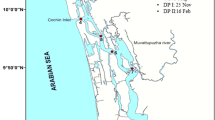Abstract
The microbiota in solar salterns plays an important role in salt production quantitatively and qualitatively. Bohai Bay coast is the major sea salt producing area in China. However, few ecological characterization studies of the Bohai Bay salt ponds, particularly of their microbial diversity, have been conducted. This study investigated the structure and diversity of the bacterial community in Hangu saltworks in response to environmental factors. The brine water was sampled from five selected saltponds within a salinity range of 5.0–19.3 % in May, July, and October, 2012. Phylogenetic analysis based on the denaturing gradient gel electrophoresis (DGGE) patterns of the PCR-amplified 16S rRNA gene fragment showed that, rather than pond salinity, especially the month of sampling influenced the structure of the bacterial community in the saltponds, which may be related to the water temperature or other factors fluctuating over the months. Moreover, canonical correspondence analysis of biological and physico-chemical parameters indicated that especially other environmental factors such as nitrogenous and phosphorous nutrient contents and pH structured the microbial community. The relatively high range-weighted richness index and Shannon–Wiener index (H′) observed in this study reflect the high level of richness and biodiversity present, though there were substantial fluctuations over the months and salinities of sampling. The fragment of 16S rRNA gene sequence recovered from DGGE bands indicated that the bacterial assemblage in Hangu Saltworks was dominated by members of γ-Proteobacteria (34 % of total sequences obtained), followed by Firmicutes (14 %) and Bacteroidetes (9 %).



Similar content being viewed by others
References
Antόn J, Rossellό-Mora R, Rodríguez-Valera F, Amann R (2000) Extremely halophilic bacteria in crystallizer ponds from solar salterns. Appl Environ Microbiol 66(7):3052–3057
Antόn J, Oren A, Benlloch S, Rodríguez-Valera F, Amann R, Rossellό-Mora R (2001) Salinibacter ruber gen. nov., sp. nov., an new species of extremely halophilic Bacteria from saltern crystallizer ponds. Int J Syst Evol Microbiol 52:485–491
APHA (1997) Standard methods for the examination of water and wastewater. American Public Health Association
Benlloch S, López-López A, Casamayor EO, Øvreås L, Goddard V, Daae FL, Smerdon G, Massana R, Joint I, Thingstad F, Pedrós-Alió C, Rodríguez-Valera F (2002) Prokaryotic genetic diversity throughout the salinity gradient of a coastal solar saltern. Environ Microbiol 4:349–360
Boon N, Top EM, Verstraete W, Siciliano SD (2003) Bioaugmentation as a tool to protect the structure and function of an activated-sludge microbial community against a 3-chloroaniline shock load. Appl Environ Microbiol 69(3):1511–1520
Boujelben I, Gomariz M, Matínez-García M, Santos F, Peña A, López C, Antόn J, Maalej S (2012) Spatial and seasonal prokaryotic community dynamics in ponds of increasing salinity of Sfax solar saltern in Tunisia. Anton Leeuw 101(4):845–857
Burns DG, Camakaris HM, Janssen PH, Dyall-Smith ML (2004) Combined use of cultivation-dependent and cultivation-independent methods indicate that members of most haloarchaeal groups in an Australian crystallizer pond are cultivable. Appl Environ Microbiol 70(9):5258–5265
Crump BC, Hopkinson CS, Sogin M, Hobbie JE (2004) Microbial biogeography along an estuarine salinity gradient: combined influences of bacterial growth and residence time. Appl Environ Microbiol 70(3):1494–1505
Deng YG, Dong JG, Huang QY, Sui LY (2014) Ecological characteristics of phytoplankton in Hangu Saltworks. Chin J Ecol 33(4):959–965 (In Chinese with English abstract)
Deng YG, Xu GC, Sui LY (2015) Isolation and characterization of halophilic bacteria and archaea from salt ponds in Hangu Saltworks, Tianjin, China. Chin J Oceanol Limnol 33(4):862–868
Fromin N, Hamelin J, Tarnawski S (2002) Statistical analysis of denaturing gel electrophoresis (DGGE) fingerprinting patterns. Environ Microbiol 4(11):634–643
Gomariz M, Martínez-García M, Santos F, Rodríguez F, Capella-Gutiérrez S, Gabaldόn T, Rossellό-Mόra R, Meseguer I, Antόn J (2015) From community approaches to single-cell genomics: the discovery of ubiquitous hyper-halophilic Bacteroidetes generalists. ISME J 9(1):16–31
Javor BJ (2002) Industrial microbiology of solar salt production. J Ind Microbiol Biotechnol 28(1):42–47
Jongman RHG, Ter Braak CJF, Van Tongeren OFR (1995) Data analysis in community and landscape ecology. Cambridge University Press, Cambridge
Maturrano L, Santos F, Rossellό-Mora R, Antón J (2006) Microbial diversity in Maras salterns, a hypersaline environment in the Peruvian Andes. Appl Environ Microbiol 72(6):3887–3895
Manikandan M, Kannan VR, Pašić L (2009) Diversity of microorganisms in solar salterns of Tamil Nadu, India. World J Microbiol Biotechnol 25(6):1007–1017
Marzorati M, Wittebolle L, Boon N, Daffonchio D, Verstraete W (2008) How to get more out of molecular fingerprints: practical tools for microbial ecology. Environ Microbiol 10(6):1571–1581
Muthu MB, Martínez-García M, Santos F, Peña A, Guven K, Antón J (2008) Prokaryotic diversity in Tuz Lake, a hypersaline environment in Inland Turkey. FEMS Microbiol Ecol 65(3):474–483
Muyzer GE, De Waal C, Uitterlinden AG (1993) Profiling of complex microbial populations by denaturing gradient gel electrophoresis analysis of polymerase chain reaction-amplified genes coding for 16S rRNA. Appl Environ Microbiol 59(3):695–700
Oren A, Rodríguez-Valera F (2001) The contribution of halophilic bacteria to the red coloration of saltern crystallizer ponds. FEMS Microbiol Ecol 36(2–3):123–130
Oren A (2002) Diversity of halophilic microorganisms: environments, phylogeny, physiology, and application. J Ind Microbiol Biotechnol 28(1):237–243
Oren A (2008) Microbial life at high salt concentrations: phylogenetic and metabolic diversity. Saline Syst. doi:10.1186/1746-1448-4-2
Wang XY, Yang HS, Sun JS, Wang Q (2011) Distribution of nutrients and eutrophication assessment in Tianjin coastal area. Chin J Mar Sci 39(9):56–61 (In Chinese with English abstract)
Yeon SH, Jeong WJ, Park JS (2005) The diversity of culturable organotrophic bacteria from local solar salterns. J Microbiol 43(1):1–10
Acknowledgments
This study was supported by the International Cooperation Research Program of the Ministry of Science and Technology of China (2010DFA32300), Natural Science Foundation of Tianjin City (13JCZDJC28700), Training Program for Changjiang Scholars and Innovative Research Team in University (2013-373), and the Pilot Project for International Cooperation funded by the Province of East-Flanders, Belgium.
Author information
Authors and Affiliations
Corresponding author
Additional information
Jiaojiao Zhang and Guannan Ma have contributed equally to the paper as first author.
Rights and permissions
About this article
Cite this article
Zhang, J., Ma, G., Deng, Y. et al. Bacterial Diversity in Bohai Bay Solar Saltworks, China. Curr Microbiol 72, 55–63 (2016). https://doi.org/10.1007/s00284-015-0916-5
Received:
Accepted:
Published:
Issue Date:
DOI: https://doi.org/10.1007/s00284-015-0916-5




